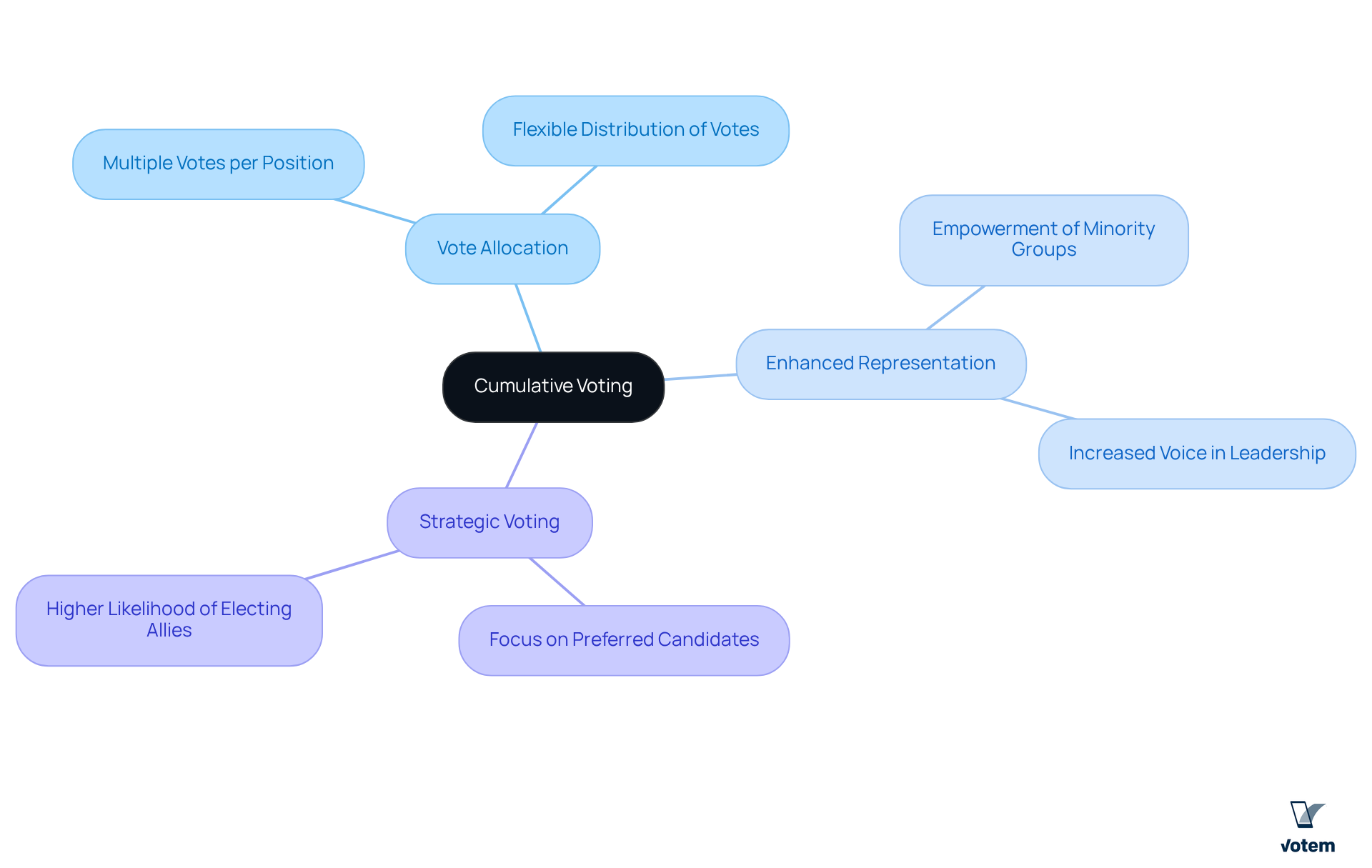Overview
Cumulative voting is a transformative voting system that empowers voters to allocate multiple votes to one or more candidates. This approach significantly enhances representation for minority groups and fosters greater voter engagement in union elections. By promoting diverse leadership and reducing electoral disputes, cumulative voting stands as a compelling solution for union leaders seeking to improve their electoral processes.
This article delineates the key principles and benefits of cumulative voting, providing a comprehensive step-by-step guide for effective implementation. Furthermore, it addresses the challenges faced by union leadership in adopting such systems, ensuring that readers are well-equipped to navigate potential obstacles. In addition, the insights shared here are designed to inspire union leaders to take action and embrace this innovative voting method.
By understanding the mechanics and advantages of cumulative voting, union leaders can create a more inclusive and representative electoral environment. This not only fosters a sense of belonging among members but also enhances overall engagement in the democratic process. As you consider the potential of cumulative voting, reflect on how this system could reshape your union’s leadership landscape and drive meaningful change.
Introduction
Cumulative voting signifies a transformative evolution in electoral processes, empowering voters to allocate multiple votes among candidates instead of being restricted to a single choice. This innovative system not only amplifies voter engagement but also guarantees that minority voices are acknowledged and represented in leadership roles.
However, as union leaders consider the adoption of cumulative voting, they may encounter challenges that could potentially diminish its effectiveness. How can these leaders adeptly navigate such obstacles while fully leveraging the advantages of this inclusive voting method?
Define Cumulative Voting: Key Concepts and Principles
The cumulative voting definition refers to a transformative voting system that empowers voters to allocate multiple votes to one or more candidates, instead of restricting themselves to a single vote for one candidate. This method proves particularly advantageous in scenarios where minority representation is essential, allowing voters to express their preferences with greater flexibility. The key principles of cumulative voting include:
- Vote Allocation: Voters receive a number of votes equal to the positions available, enabling them to distribute their votes among candidates as they choose.
- Enhanced Representation: This system significantly empowers minority groups within the organization, ensuring their voices are acknowledged and represented in leadership roles.
- Strategic Voting: Voters can focus their votes on preferred candidates, thereby increasing the likelihood of electing representatives who resonate with their interests.
Understanding these principles is crucial for labor leaders seeking to effectively utilize the cumulative voting definition in their election processes. By promoting cumulative voting, they can foster a more inclusive and representative decision-making process that addresses the diverse needs of their constituents.

Apply Cumulative Voting in Union Elections: Benefits and Use Cases
The cumulative voting definition highlights significant advantages for union elections, making it a compelling choice for labor leaders seeking to enhance democratic practices.
Increased Voter Engagement: By enabling voters to express their preferences more freely, cumulative voting fosters higher turnout rates. Members feel their votes carry greater weight, thus motivating participation.
Diverse Leadership: This voting method promotes the appointment of candidates from varied backgrounds, thereby enriching diversity within organizational leadership. Such diversity is essential for addressing the needs of all members.
Conflict Reduction: Moreover, cumulative balloting can alleviate electoral disputes. By ensuring that minority groups have a fair opportunity for representation, it reduces the likelihood of contested polls, fostering a more harmonious electoral environment.
Use Cases:
- Labor Unions: Numerous labor unions have embraced cumulative voting to guarantee that all members, particularly those from underrepresented groups, have a voice in leadership elections.
- Pension Funds: This selection method is also utilized in pension fund processes, allowing stakeholders to influence decisions that impact their financial futures.
These advantages make proportional selection an attractive option for labor leaders dedicated to improving democratic practices within their organizations.

Implement Cumulative Voting: Step-by-Step Guide for Union Leaders
To implement cumulative voting in union elections, follow these essential steps:
-
Inform Members: Begin by educating the organization’s members about collective election methods, emphasizing their advantages and the process involved. Host informational sessions or distribute educational materials to ensure comprehensive understanding.
-
Amend Bylaws: Review and modify the union’s bylaws to incorporate cumulative election procedures. It is crucial that all members grasp the changes and their implications, fostering transparency and engagement.
-
Establish Election System: Select a secure platform for casting ballots, such as Votem’s CastIron, renowned for enhancing accessibility for all eligible voters, including military personnel and individuals with disabilities. This platform not only meets compliance standards but also delivers a user-friendly experience, as highlighted by satisfied clients who have effectively utilized it.
-
Conduct a Test Vote: Prior to the official ballot, conduct a test vote to familiarize members with the process and address any potential technical issues. This proactive measure can significantly enhance confidence among participants.
-
Launch the Election: Announce the election date and provide clear instructions on how to cast a ballot using the cumulative voting system. Ensure that all members have access to the election platform, which has successfully managed large volumes of votes, as evidenced by Votem’s experience with the National Radio Hall of Fame, where they handled 299,000 votes.
-
Monitor and Support: During the election period, oversee participation and offer assistance to members who may have inquiries or face challenges. This support is vital for fostering a smooth electoral process.
-
Count Votes and Announce Results: After the balloting period concludes, accurately tally the votes and announce the results promptly, ensuring transparency throughout the process.
By adhering to these steps and employing Votem’s innovative solutions, organizational leaders can effectively introduce what is known as the cumulative voting definition, promoting a more inclusive and representative electoral process.

Navigate Challenges in Cumulative Voting: Common Issues and Solutions
While collective balloting offers numerous advantages, union leaders may encounter challenges in its implementation. Here are some common issues along with effective solutions:
-
Member Confusion: Some members may find it difficult to grasp the concept of cumulative voting.
Solution: To address this, provide clear and concise educational materials, and organize Q&A sessions to resolve any uncertainties. -
Technical Difficulties: Problems with the polling platform can impede participation.
Solution: It is crucial to choose a reliable platform for elections, such as Votem’s CastIron, which offers technical support and user-friendly interfaces. Conducting a test run prior to the official election can also mitigate potential issues. -
Resistance to Change: Some members may be reluctant to embrace a new selection method.
Solution: Highlight the benefits of collective ballot procedures, such as improved representation and increased involvement, to foster support among all members. -
Vote Tallying Complexity: The process of tallying ballots in a collective assessment system can be more complex than traditional methods.
Solution: Implement automated counting features available through secure ballot platforms to streamline the process and ensure accuracy.
By proactively addressing these challenges, union leaders can facilitate a smoother transition to the cumulative voting definition, ultimately strengthening the democratic process within their organizations.

Conclusion
Cumulative voting signifies a pivotal transformation in the conduct of elections within unions, offering a more equitable and inclusive approach. By empowering voters to allocate their votes among multiple candidates, this method not only enhances representation for minority groups but also fosters a more engaged electorate. The adoption of cumulative voting has the potential to reshape the decision-making landscape within unions, ensuring that every member’s voice is acknowledged and valued.
The article delineates the essential principles of cumulative voting, including:
- Vote allocation
- Enhanced representation
- Strategic voting
While underscoring its practical advantages in union elections, key arguments highlight:
- Increased voter engagement
- Diverse leadership
- Conflict reduction
Illustrating how cumulative voting can alleviate common electoral disputes and cultivate harmony within organizations, a step-by-step guide equips union leaders with actionable insights for the successful implementation of this system, addressing potential challenges and providing solutions to facilitate a seamless transition.
Ultimately, embracing cumulative voting transcends the mere adoption of a new electoral method; it embodies the commitment to fostering a culture of inclusivity and empowerment within unions. By prioritizing diverse representation and encouraging active participation, union leaders can cultivate a more democratic environment that genuinely reflects the needs and aspirations of all members. Taking the initiative to implement cumulative voting can lead to stronger, more resilient unions, better equipped to navigate the complexities of modern labor relations.
Frequently Asked Questions
What is cumulative voting?
Cumulative voting is a voting system that allows voters to allocate multiple votes to one or more candidates, rather than being restricted to a single vote for one candidate.
What are the key principles of cumulative voting?
The key principles of cumulative voting include vote allocation, enhanced representation for minority groups, and strategic voting, which allows voters to focus their votes on preferred candidates.
How does cumulative voting benefit minority representation?
Cumulative voting empowers minority groups by ensuring their voices are acknowledged and represented in leadership roles, thereby enhancing their representation within the organization.
How does vote allocation work in cumulative voting?
In cumulative voting, voters receive a number of votes equal to the positions available, allowing them to distribute their votes among candidates as they choose.
What is the significance of strategic voting in cumulative voting?
Strategic voting in cumulative voting allows voters to concentrate their votes on candidates they prefer, increasing the chances of electing representatives who align with their interests.
Why is understanding cumulative voting important for labor leaders?
Understanding cumulative voting is crucial for labor leaders as it helps them effectively utilize this voting method in elections, promoting a more inclusive and representative decision-making process that addresses the diverse needs of their constituents.

